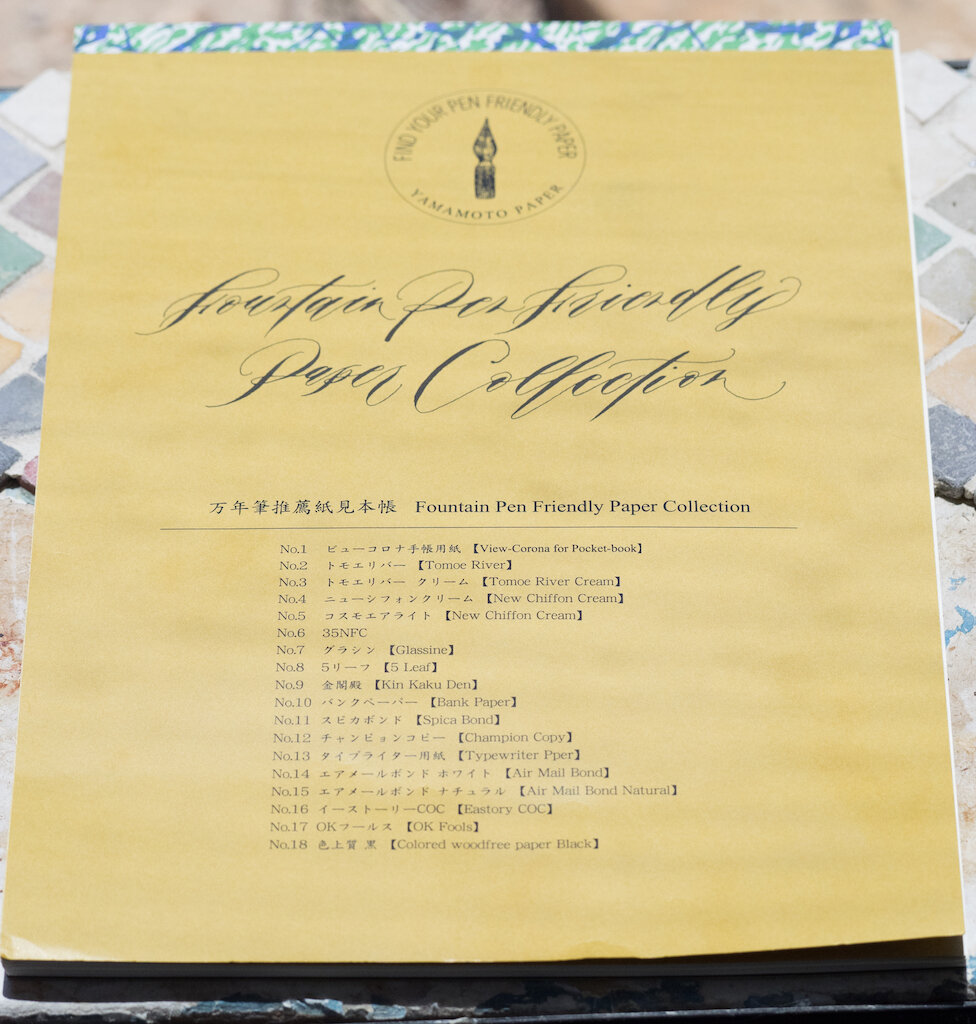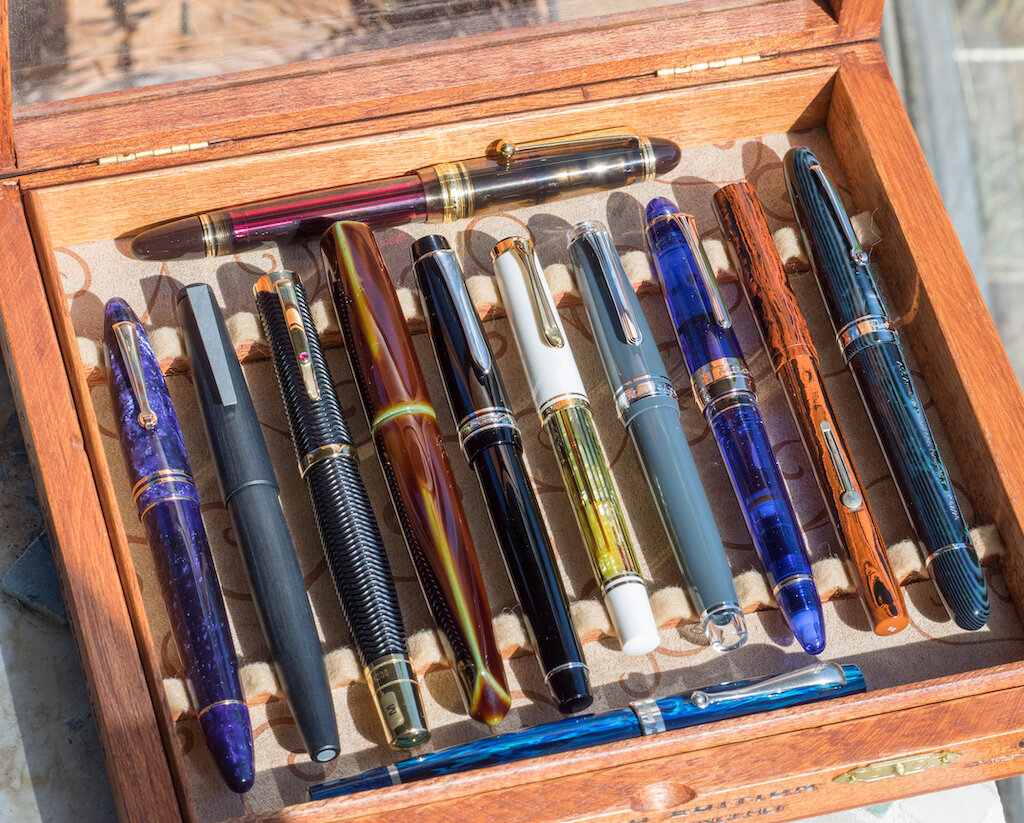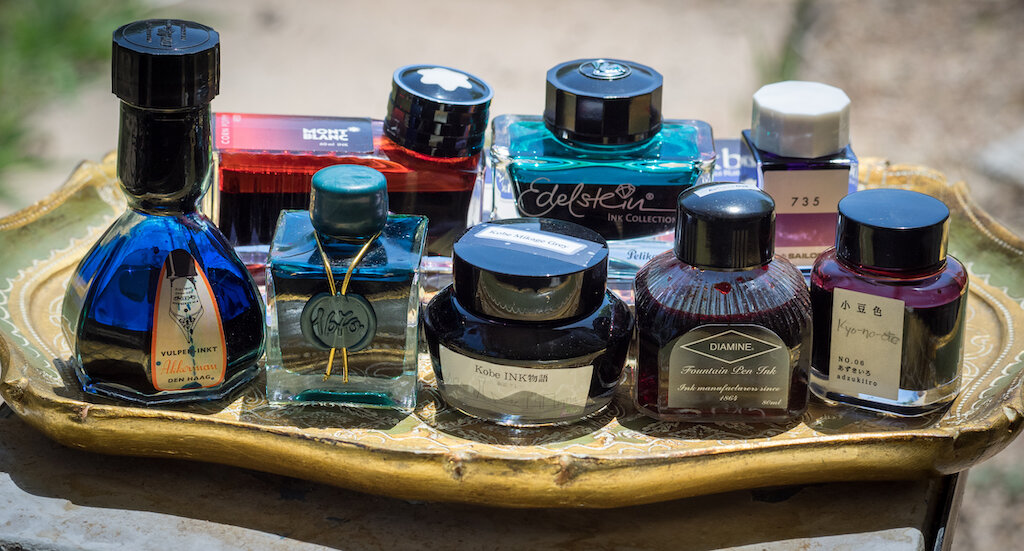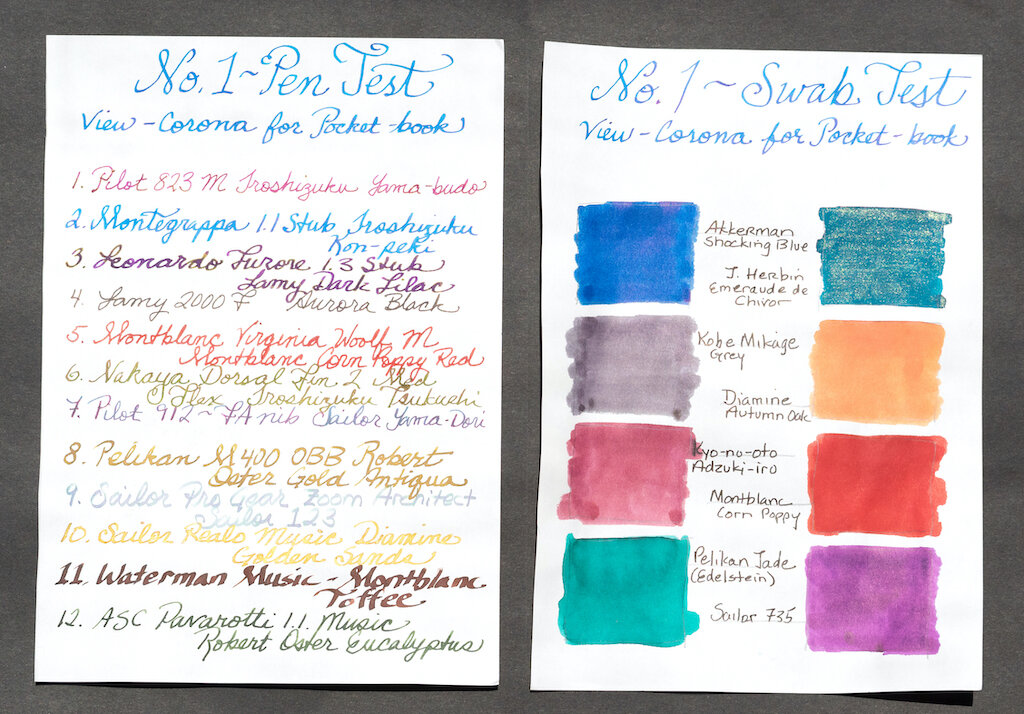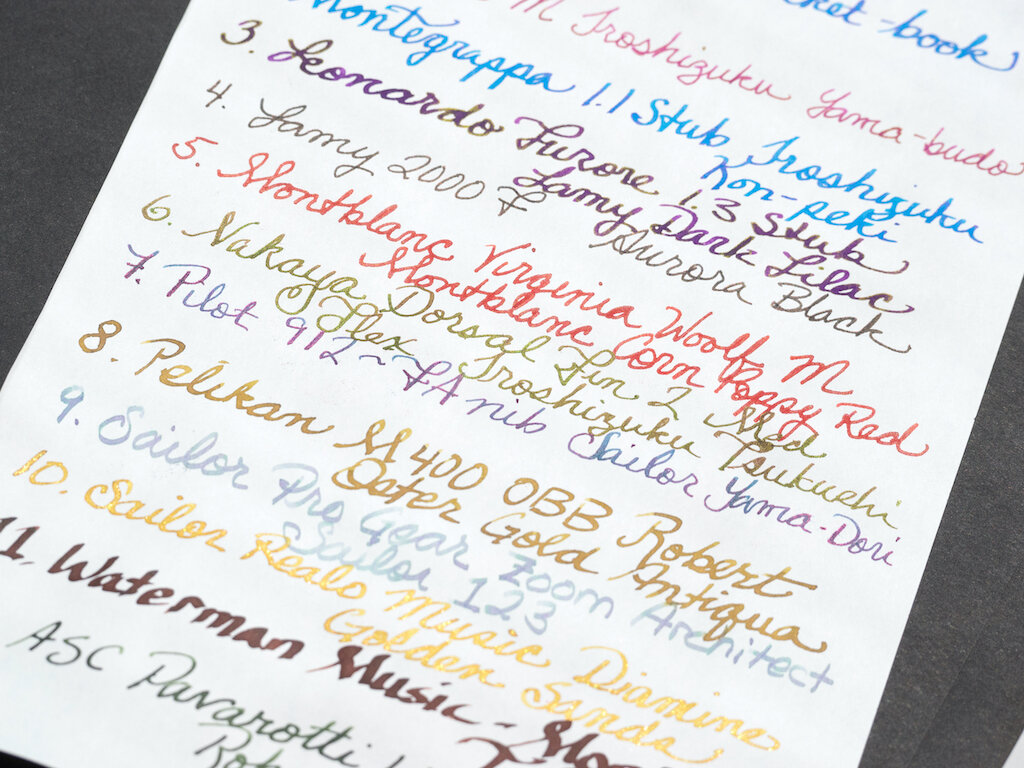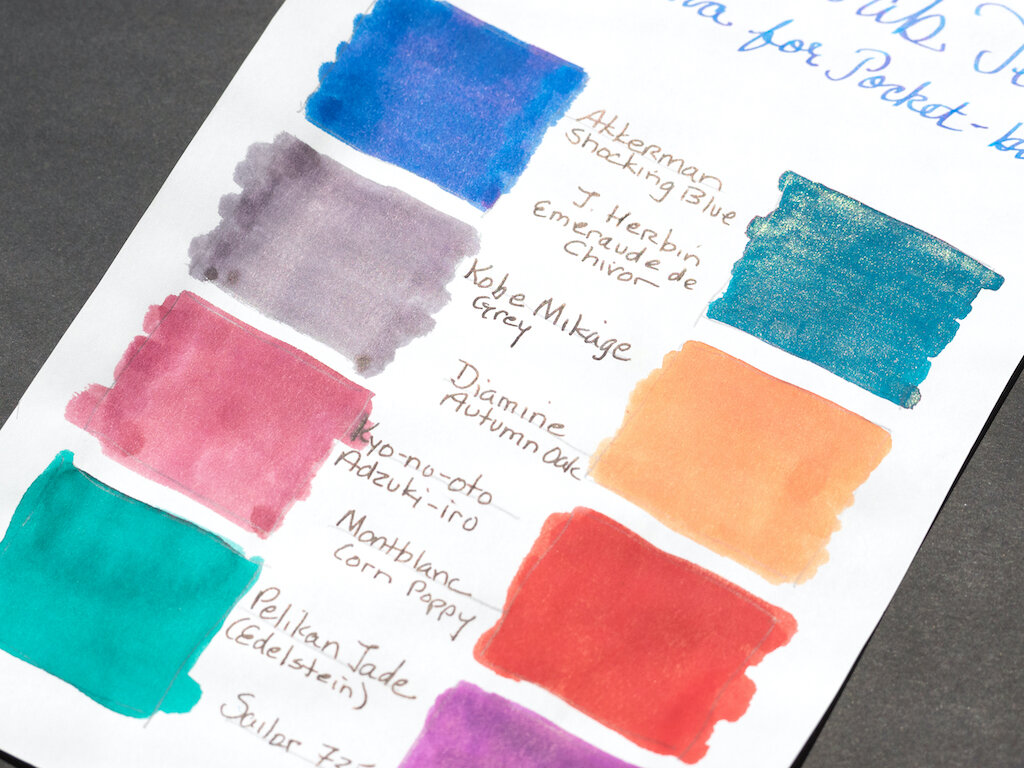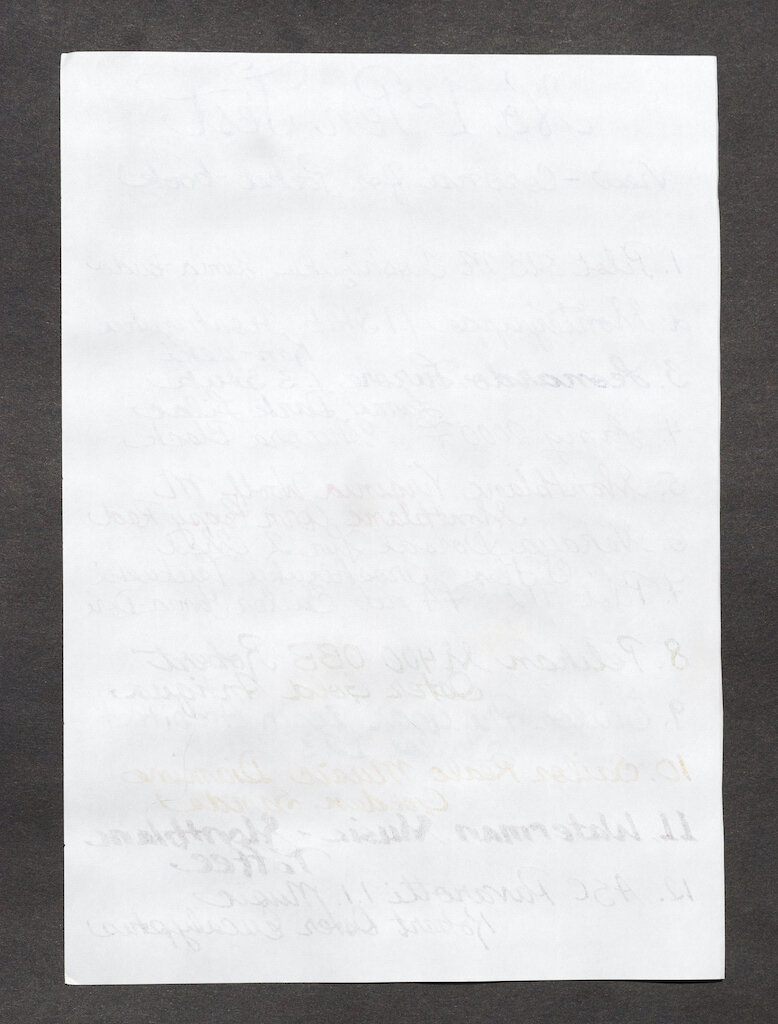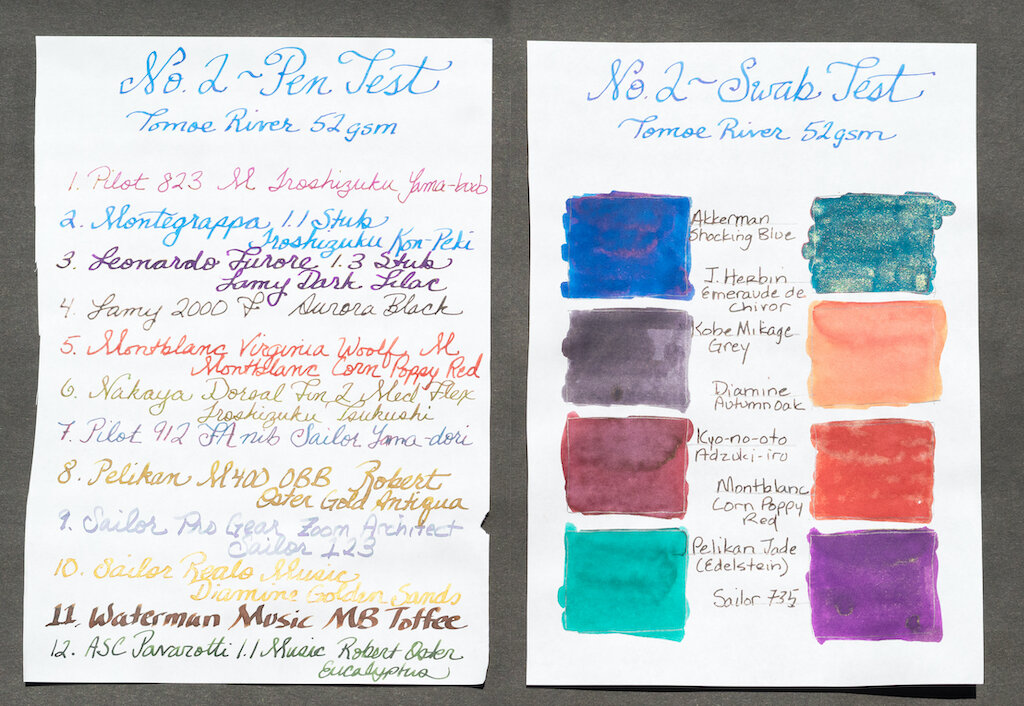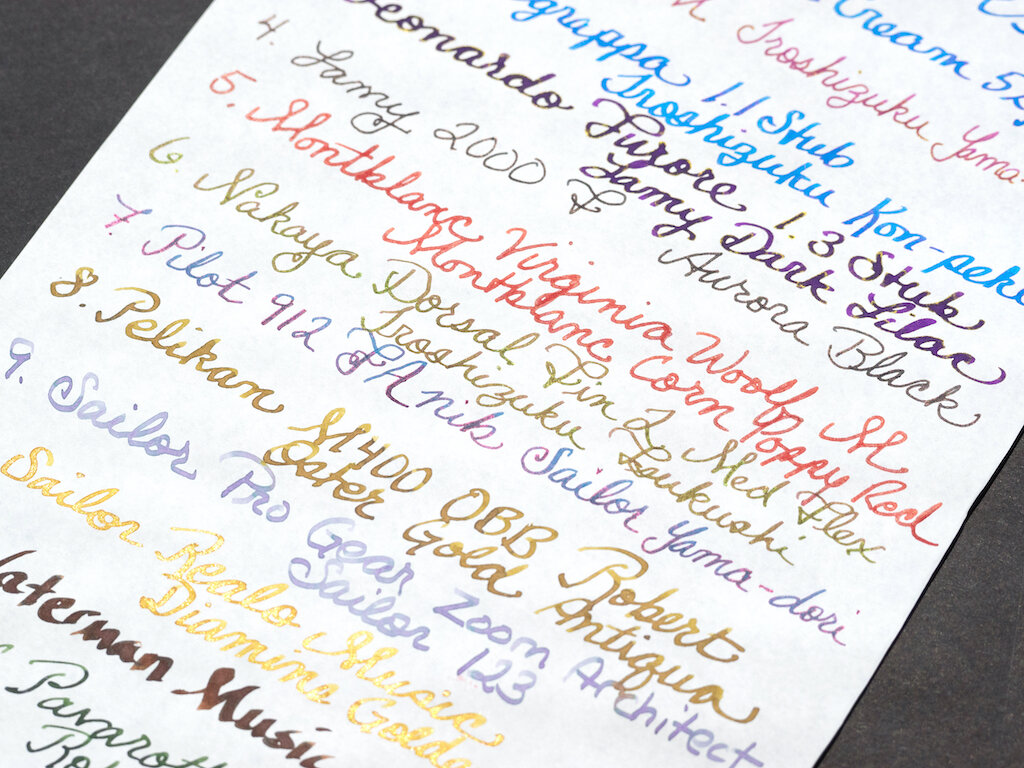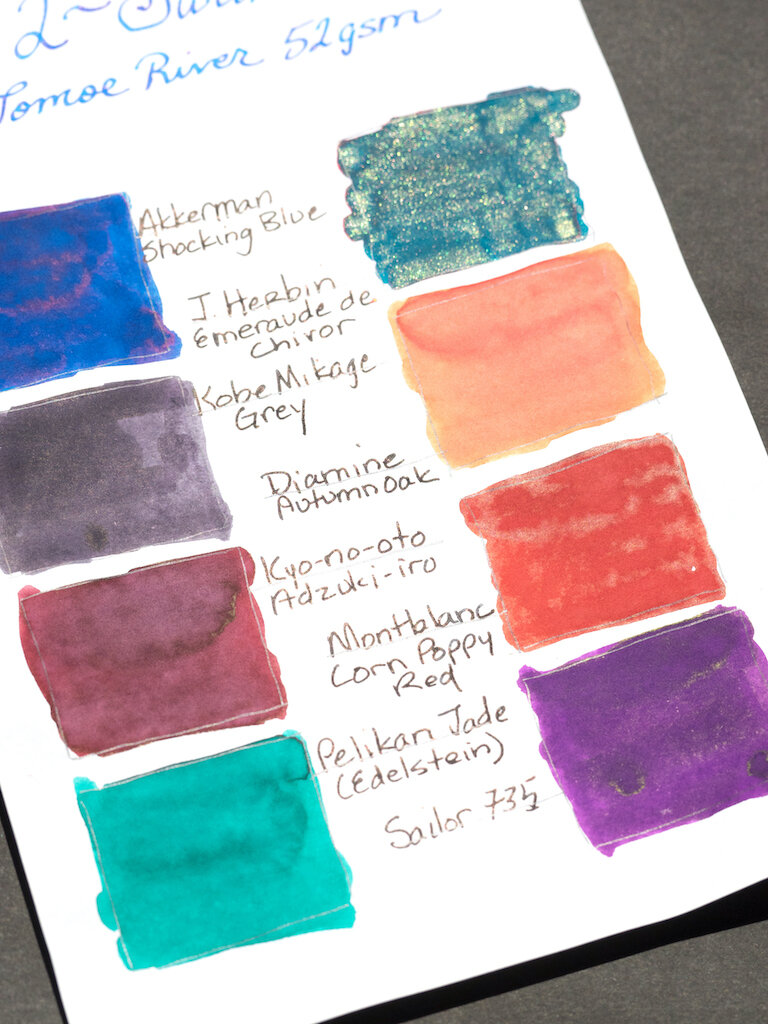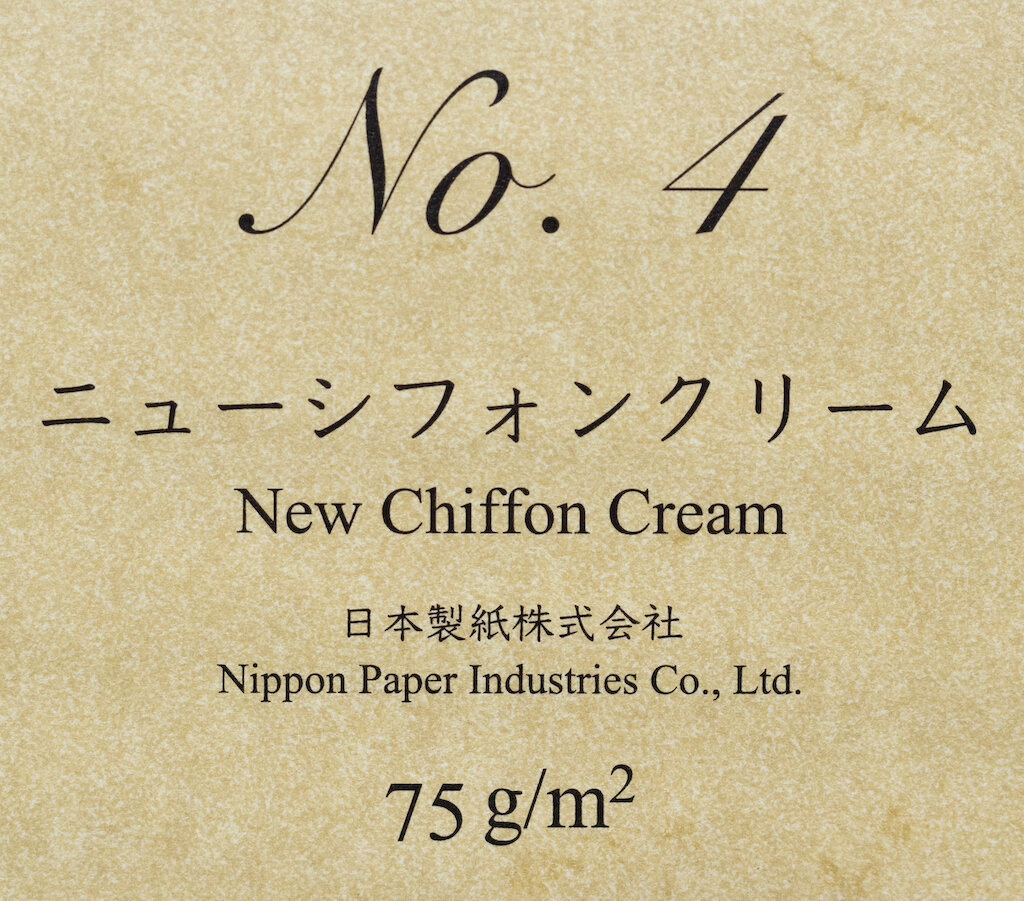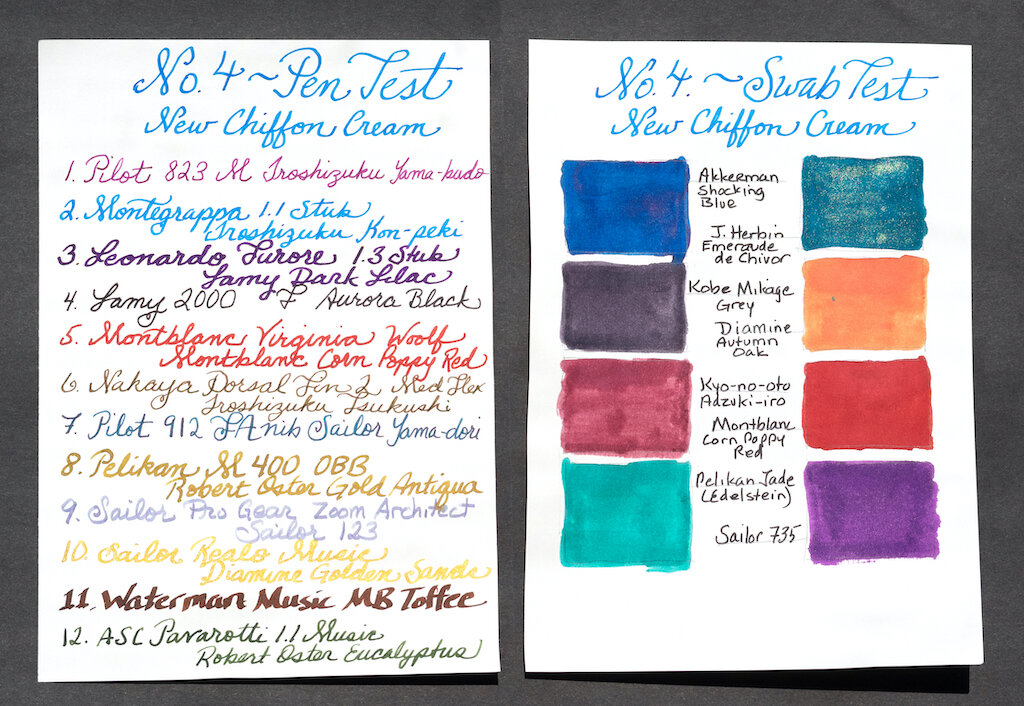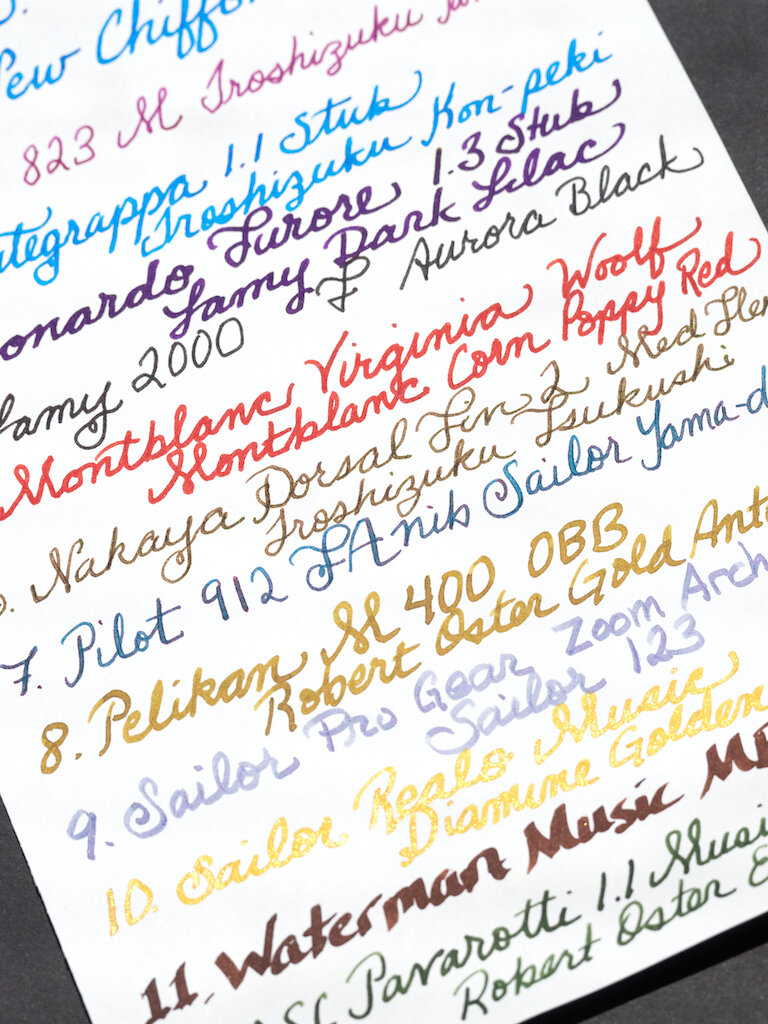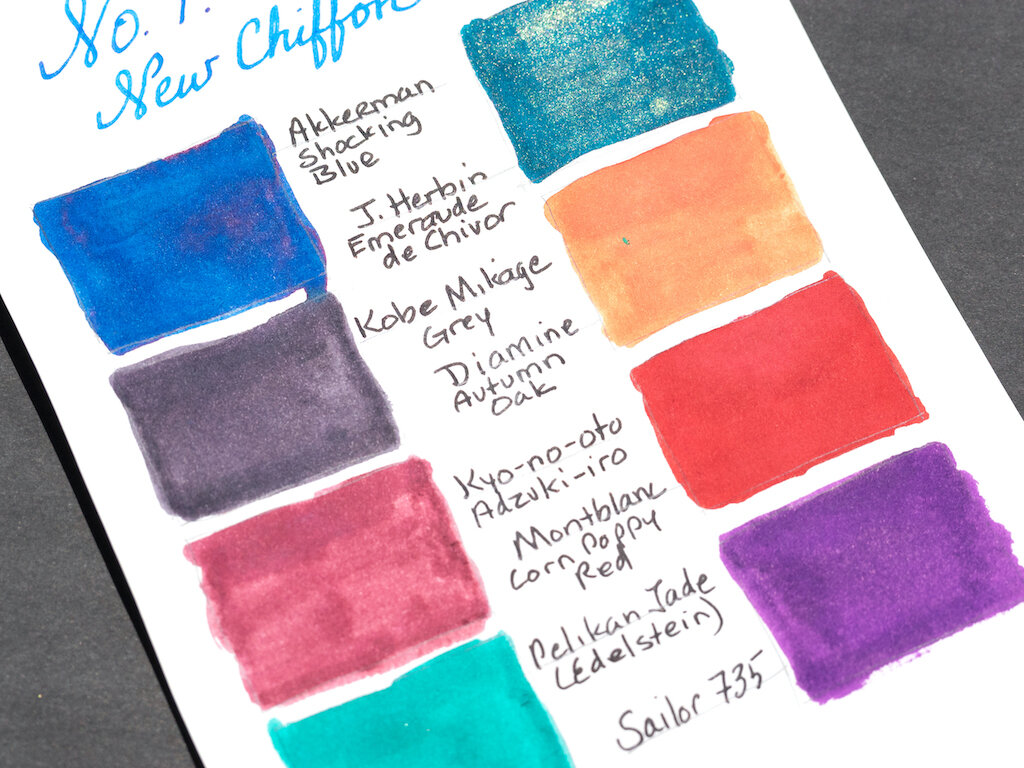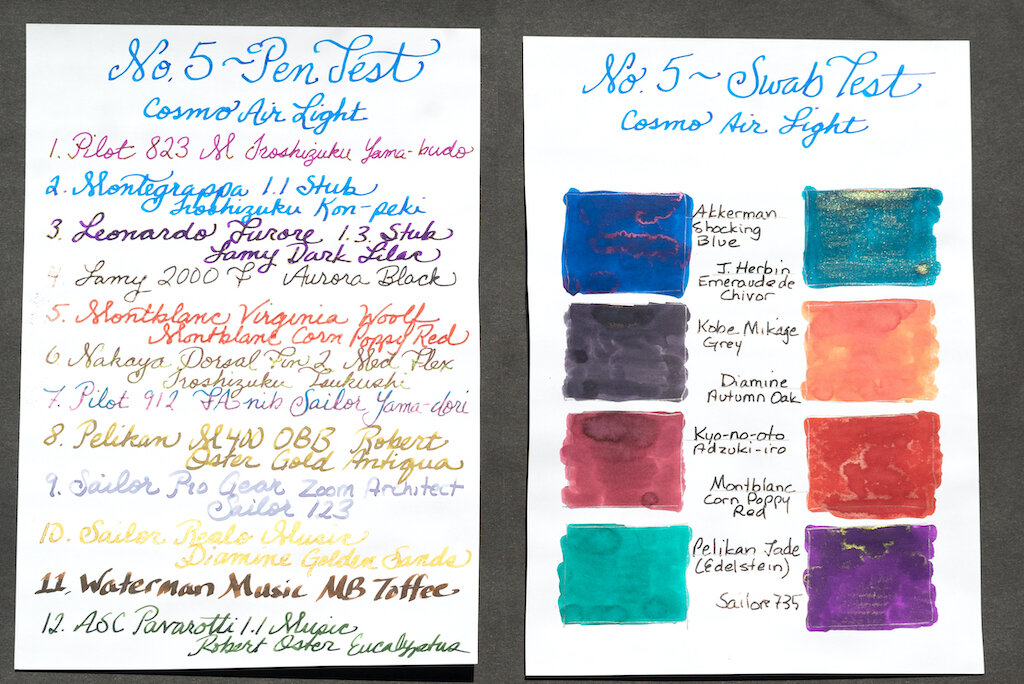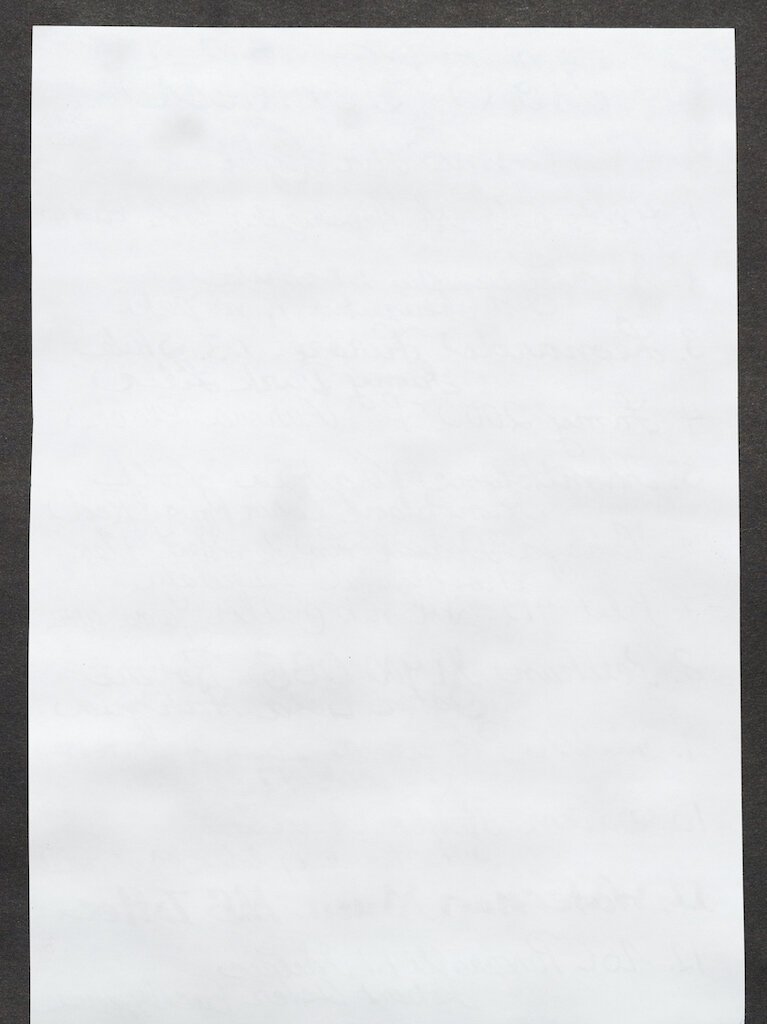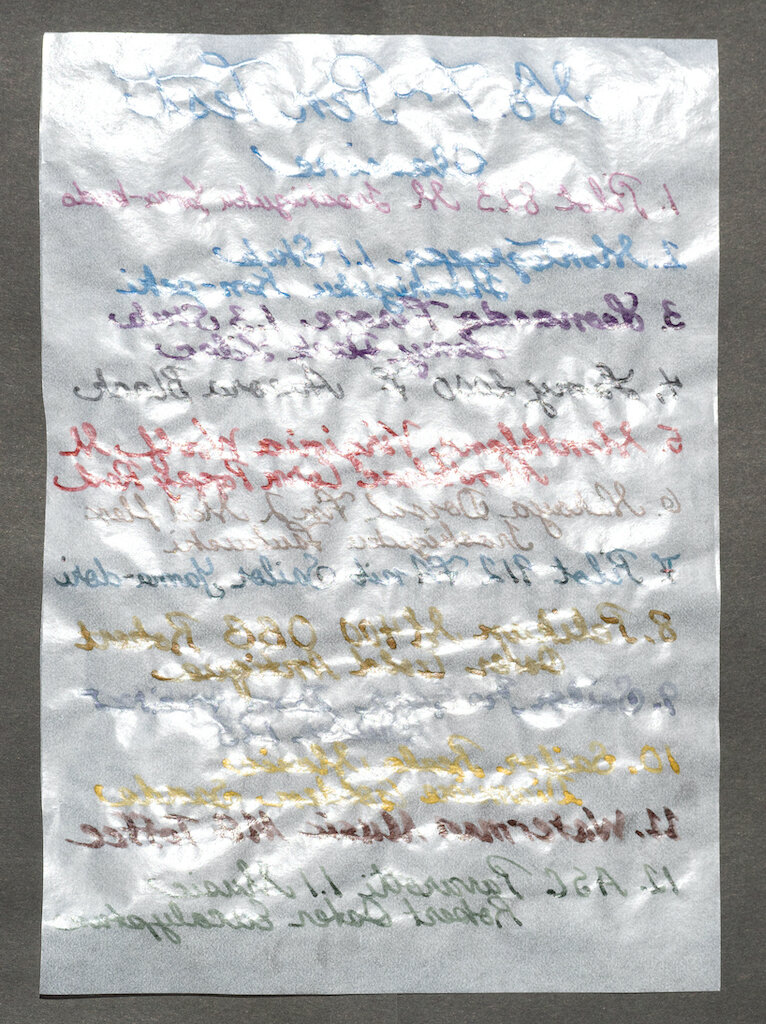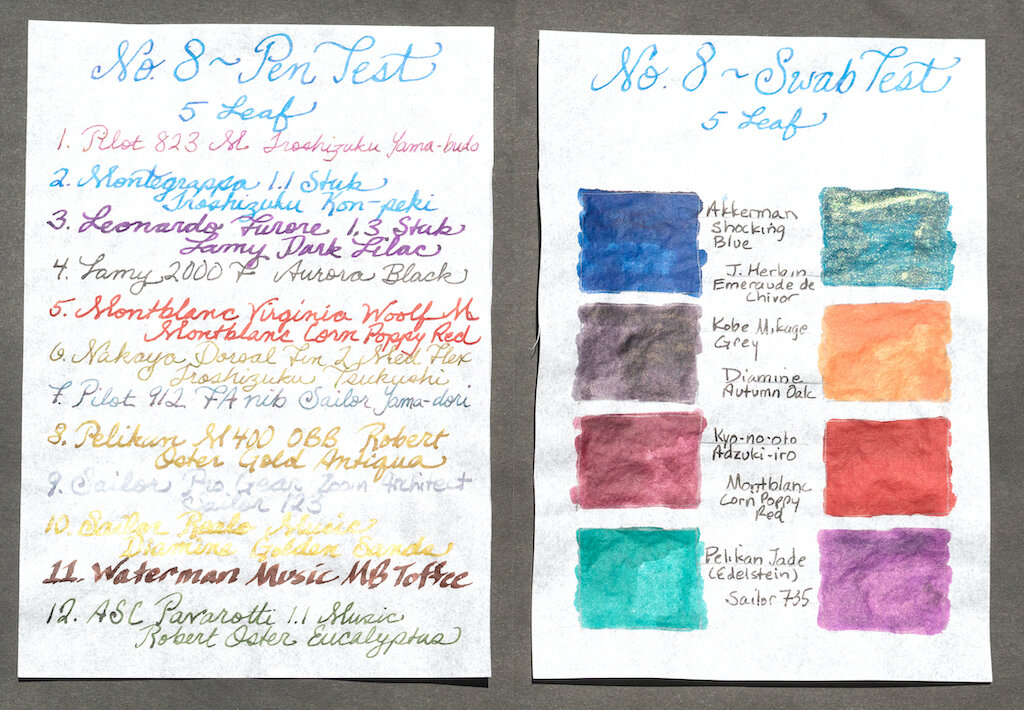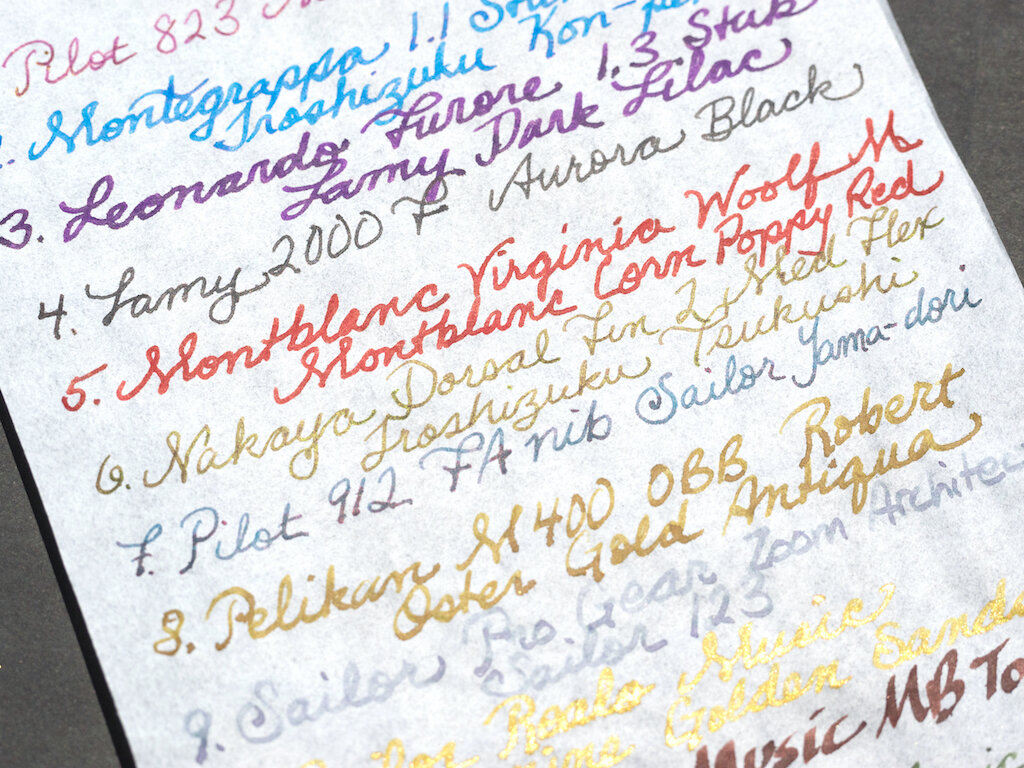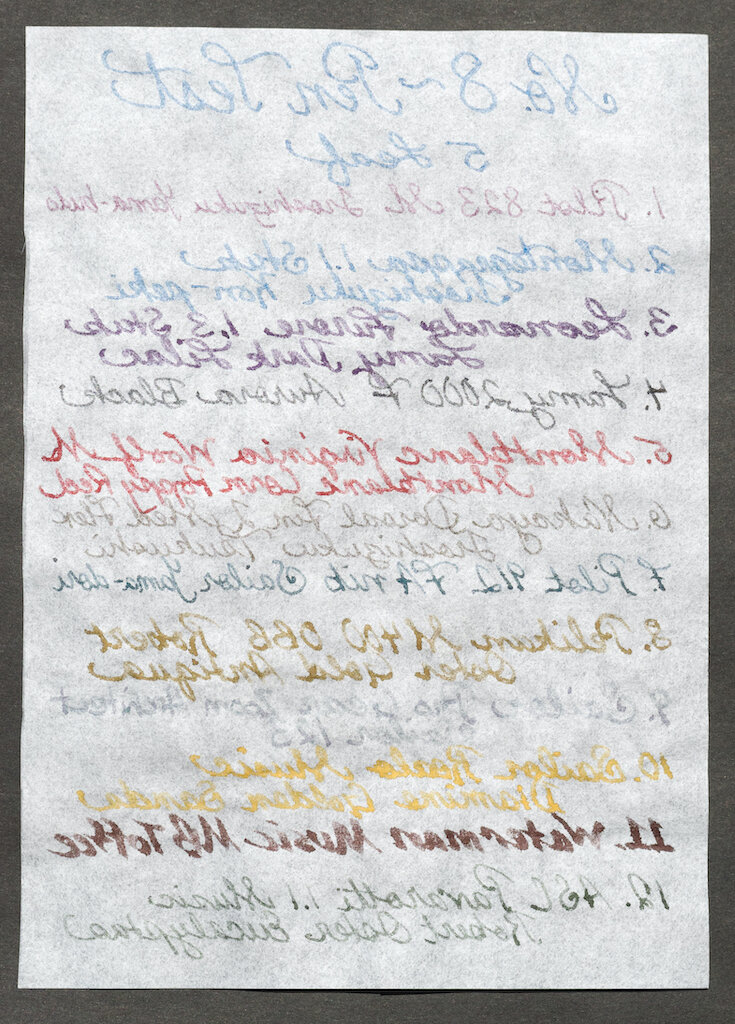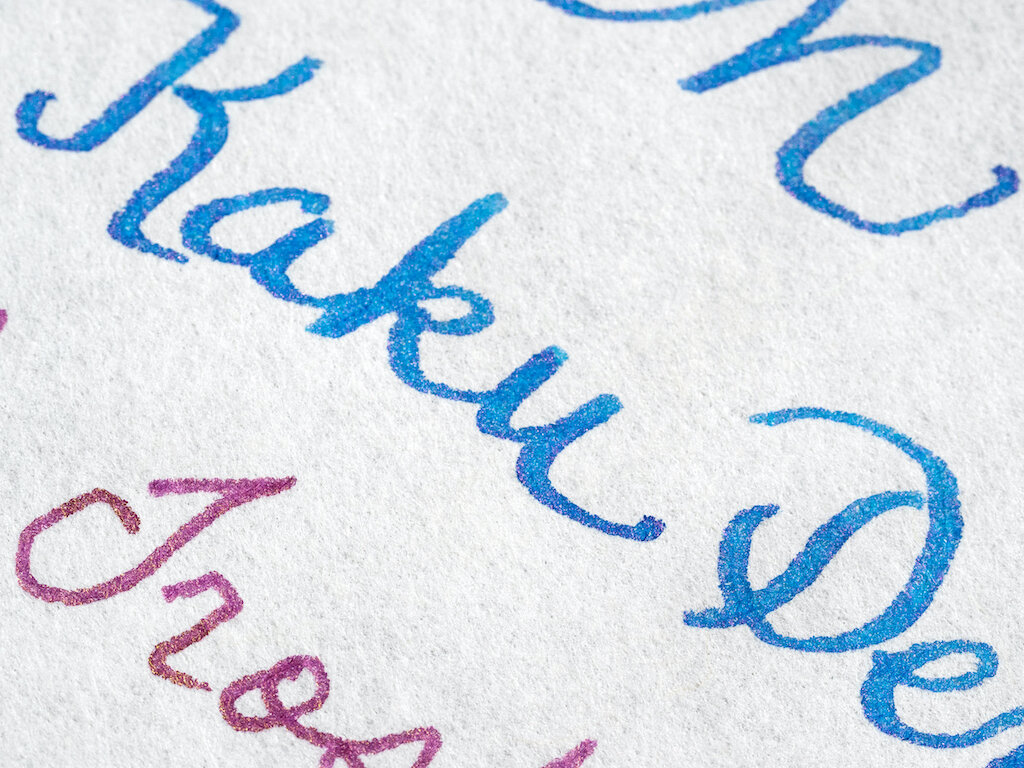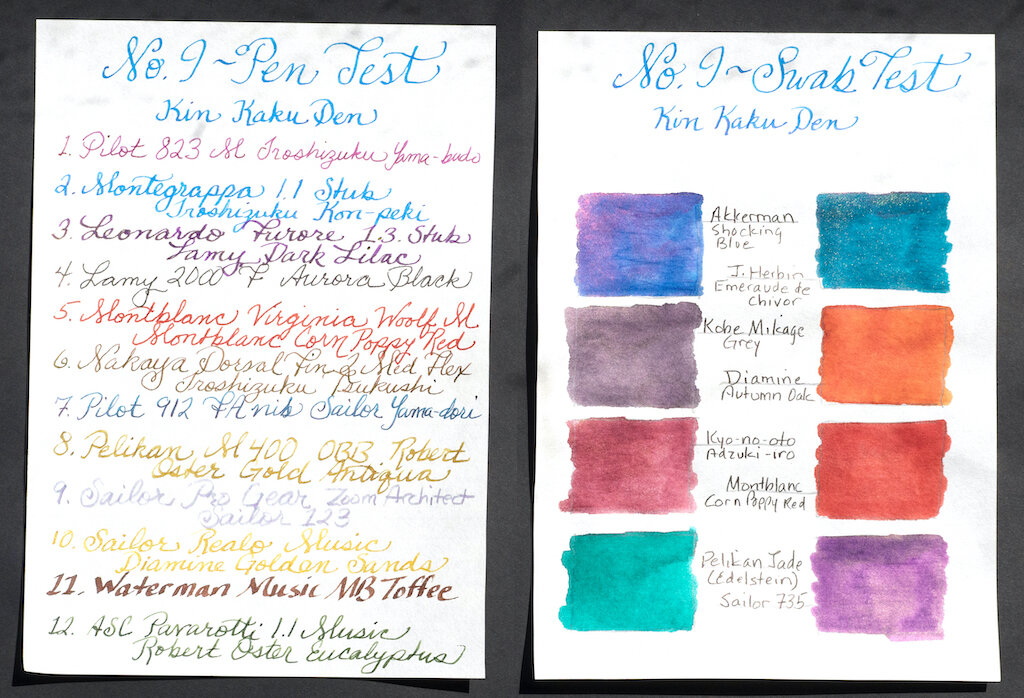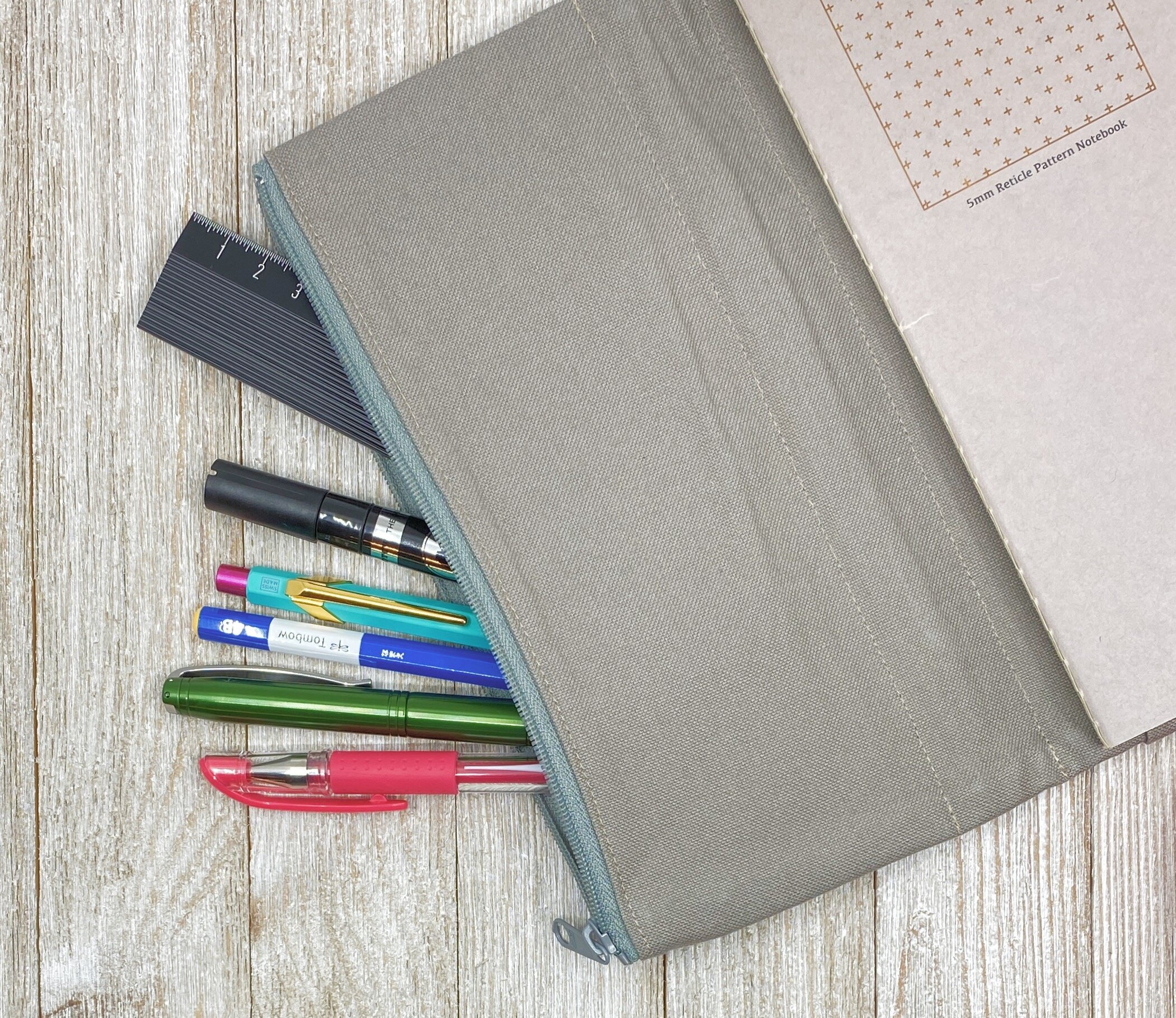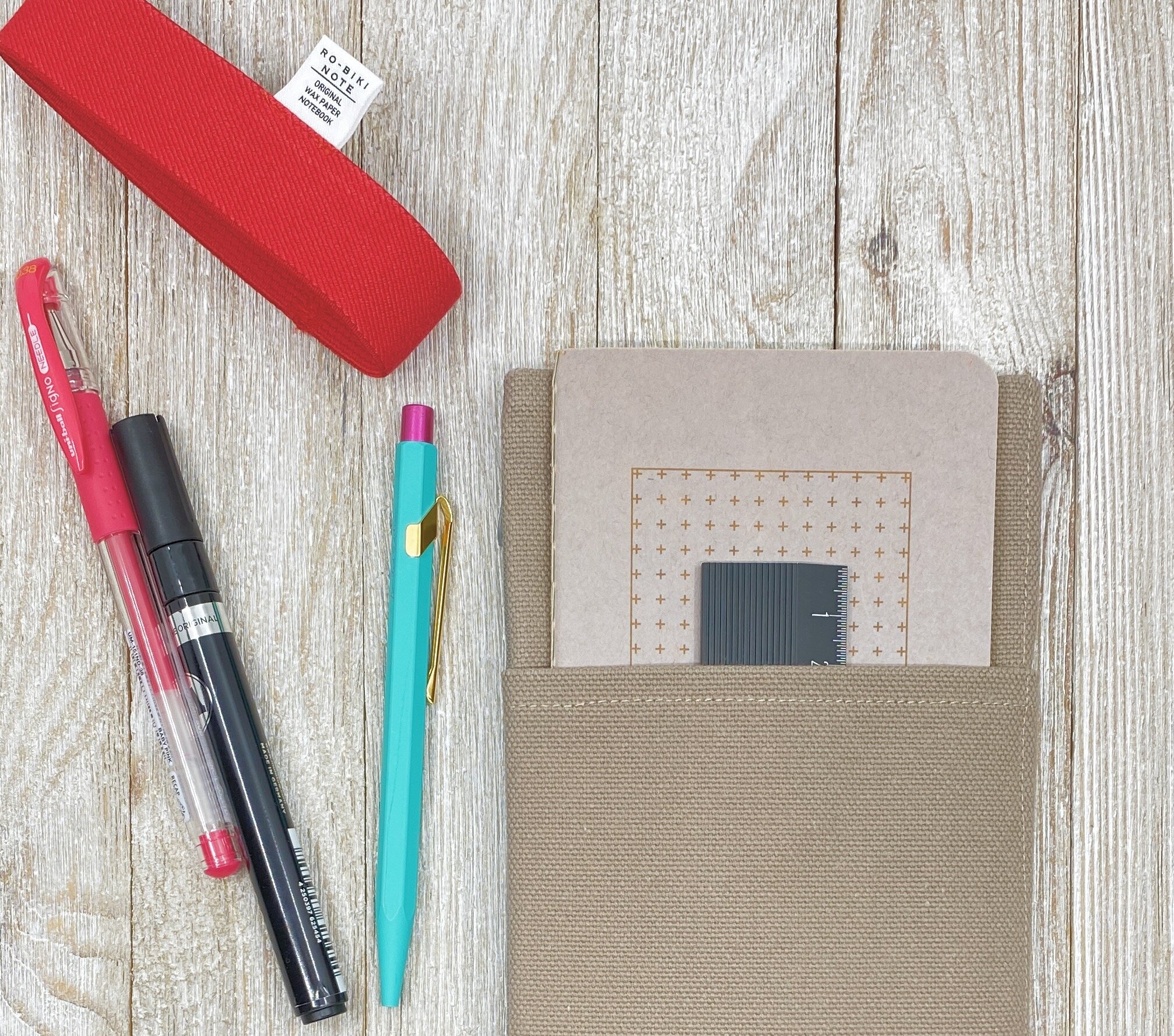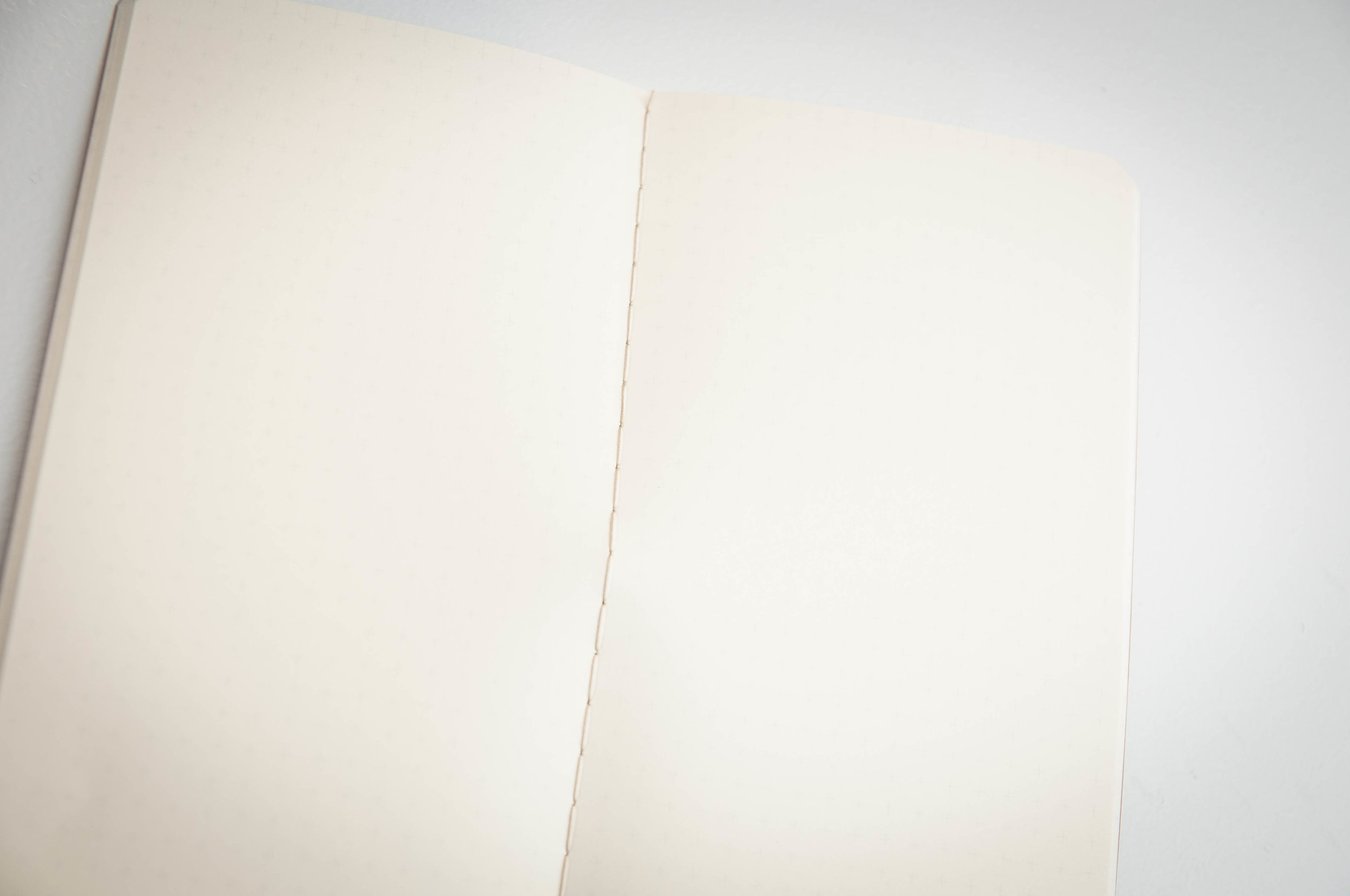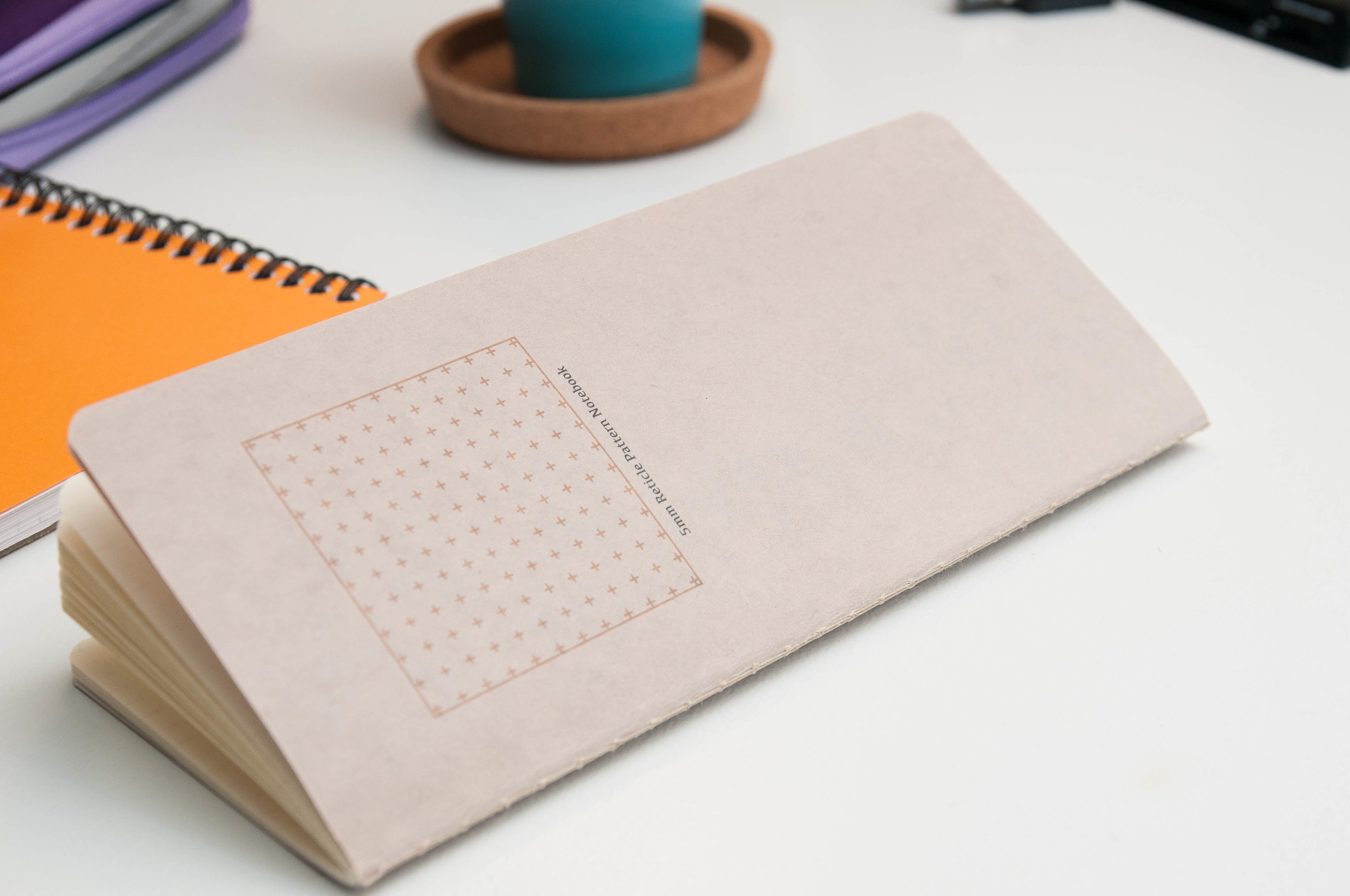(Susan M. Pigott is a fountain pen collector, pen and paperholic, photographer, and professor. You can find more from Susan on her blog Scribalishess.)
Brad sent me the Fountain Pen Friendly Paper Collection by Yamamoto Paper to review several months back. It sat quietly in my queue, until one evening, a few weeks ago, I removed the plastic and flipped through the pad. I was stunned into silence. I’ve received paper collections before, but I’ve never seen anything like this one. Preceding each set of paper there’s a golden parchment page that details where the paper is made, the history behind the paper, and a brief description of its characteristics.
I totally geeked out, reading the descriptions then tracing my fingers over each paper, feeling its smoothness or texture, measuring its thickness, delighting in its crinkles as I turned the pages. Audible gasps and exclamations of “Ooooo,” emerged from my home office. I carried the pad reverently into the living room where I told my husband that I was holding a veritable treasure trove of precious paper. He just shook his head and went back to reading his book. I do not understand him.
The paper in this collection isn’t just paper. Rather, each set reflects the science and artistry of various paper makers who developed the paper for specific purposes. I am fascinated by this, because the interaction between pen, ink, and paper is often a mysterious alchemy. Some papers bring out the vibrant colors and sheen of ink. Other papers offer a more tactile writing experience because of their texture. Still others have the perfect combination of thickness, texture, and absorption that makes writing an absolute pleasure. And who doesn’t love the crinkly feel and sound of quality paper?
Below, I include the description of each paper (as written by Yamamoto Paper) followed by my own observations. To test the paper, I used twelve pens with various nibs and ink types and eight different inks for swabbing. I wanted to offer a variety of nib sizes from fine to extra broad (music). I also attempted to use many different brands of inks, but ultimately I emphasized color over manufacturer variety.
This is part one of my review, in which I discuss the first nine papers in the collection. Next week I will review the remaining nine.
Pens
The following pens were used on each type of paper:
- Pilot Custom 823, medium nib, inked with Iroshizuku Yama-budo
- Montegrappa Mia, 1.1 stub nib, inked with Iroshizuku Kon-peki
- Leonardo Furore, 1.3 stub nib, inked with Lamy Dark Lilac
- Lamy 2000, fine nib, inked with Aurora Black
- Montblanc Virginia Woolf, medium nib, inked with Montblanc Corn Poppy Red
- Nakaya Dorsal Fin 2, medium stub flex nib, inked with Iroshizuku Tsukushi
- Pilot Custom Heritage 912, FA nib, inked with Sailor Yama-dori
- Pelikan M400, OBB nib, inked with Robert Oster Gold Antiqua
- Sailor Pro Gear, Zoom Architect nib, inked with Sailor 123
- Sailor Realo, Music nib, inked with Diamine Golden Sands (shimmer ink)
- Waterman, Music nib, inked with Montblanc Toffee
- ASC Pavarotti, 1.1 Music nib, inked with Robert Oster Eucalyptus
Inks
The following inks were used for swabbing on each type of paper:
- Akkerman Shocking Blue
- J. Herbin Emeraude de Chivor (shimmer ink) (turquoise)
- Kobe Mikage Grey
- Diamine Autumn Oak (orange)
- Kyo-no-oto Adzuki-iro (pink/burgundy)
- Montblanc Corn Poppy (I tried not to repeat inks from the pen tests, but this is my best red ink)
- Pelikan Jade (Edelstein) (green)
- Sailor 735 (purple)
No. 1 ~ View-Corona for Pocket-book (52 gsm)
View-Corona for Pocket-book is made at the Oji F-Tex Tokai factory. This factory, formally known as Toyo Kako-shi was established in 1919 to produce rolling paper for tobacco and carbon copy paper. Currently this Tokai factory produces a wide range of highly technical specialty papers, such as ultra-thin dictionary paper, contaminant controlled medical paper, and magnetically coated papers for use as train tickets and parking tickets. This View-Corona for Pocket-book is also made with very specialized technologies to give it thinness, lightness, bleed-through protection, and a smooth writing experience.
Although View-Corona paper is intended for printing dictionaries and books, it is also excellent for fountain pens. It is a cream-colored paper that is quite similar Tomoe River Paper, but it feels just a tad more substantial to me (even though it is 52gsm, just like Tomoe). It has a smooth, untextured surface that allows ink to glide over it, and it brings out both shading and sheen in inks that have it. Shimmer ink also shows up well on this paper.
Colors show up nicely in swabs, though sheen wasn’t as prominent as on other papers. This was my first swab test, and I didn’t lay down the ink as thickly as I did on subsequent papers, so that may be why the inks didn’t display as much sheen.
Because of the thinness of the paper, there is show through, but none of the inks I tested exhibited any bleed through.
For writers who find Tomoe River paper just a bit too thin, this might be a good alternative. Unfortunately, I couldn’t find a website for “Pocket-book” (if that is a brand), so I’m not sure how you could purchase a notebook with this paper. I did find the page describing the paper on the Oji F-Tex site.
Nos. 2 and 3 ~ Tomoe River White and Cream (52 gsm)
Tomoe River is known for being thin and light. It handles fountain pens, ball-point pens, and pencils well, and the softness of the paper makes it easy for notebooks to lie flat. It has gained worldwide attention as the paper used by the Hobonichi Techo. Unfortunately, the Tomoe River paper mill announced in 2019 that it will be shutting down one of the factories they use to make this paper and will be outsourcing the manufacturing to another company. Due to the declining demand for paper, many paper companies seem to be reassessing their supply chain and manufacturing processes to achieve greater efficiencies and cost savings.
As stated in the above description, Tomoe River paper has become ubiquitous in the fountain pen community. Not only is it used in the Hobonichi Techo, it is used in the Seven Seas Writer, Hippo Noto notebooks, and many others, including Goulet.
In this collection, only the 52gsm version of Tomoe River paper is represented (a thicker 68gsm version is available from Hippo Noto and Goulet). Both the white and cream varieties provide a smooth writing surface for fountain pens. Tomoe River paper’s superpower is bringing out both shading and sheen from inks. You can see this clearly in the photos below.
The paper is quite thin so show-through is a given. However, none of the inks in my tests bled through--even the very wet Waterman Music nib inked with Montblanc Toffee.
I’m a huge fan of Tomoe River paper, so the fact that the company plans to outsource manufacturing disturbs me. I hope the paper retains its quality. As I said above, you can find Tomoe River paper from many different sources now, but my favorite journal with Tomoe River is the Seven Seas Writer.
No. 4 ~ New Chiffon Cream (75 gsm)
New Chiffon Cream is a light-cream colored book paper that is thick, light, and soft. Book paper, or high bulk paper, was developed to meet the needs of publishers who wanted a paper that balanced portability with thickness. It is a paper with low fiber density that is very light for its thickness. Its lightness makes it easy to carry without being brittle. It is suited for printing both text and images, and does not allow any bleed-through on the page. In addition to these great properties, New Chiffon Cream is PH neutral so it does not discolor over time, offering great archivability. In our ink tests, Sailor and Platinum inks dried almost immediately and showed no bleed-through. Some very wet inks, such as J. Herbin inks, showed slight bleed-through. However, the slightly rough surface provides a wonderful feel when writing. We at Yamamoto Paper like this paper so much, that we use it in our very own > > > > > > RO-BIKI NOTE> > > > > > notebooks. We highly recommend using this paper with ballpoints and fountain pens.
Oh myyyy, I love this paper. It is buttery soft with a bit of texture, quite unlike Tomoe River paper. Ink soaks in and dries quickly, so you won’t experience smudging while writing (lefties take note!) The first word that came to mind when I started my pen tests on this paper was “yummy.” Truly, this paper is delightful to write on. Sheen lovers may not care for this paper as it soaks up ink too quickly for much sheen to form. Nevertheless, it does exhibit good shading.
Although show through isn’t much of a problem with New Chiffon Cream, bleed through is (with wide nibs and wet inks).
I’d say that people who don’t like Tomoe River paper will probably love this paper. Unfortunately, the RO-BIKI notebooks only come in 91x210mm and 91x135mm sizes (no A5 notebooks). Plus, the Yamamoto Paper Etsy shop is currently closed. Still, I’m so impressed with this paper that I plan to buy some RO-BIKI notebooks just for the sheer pleasure of writing in them as soon as the shop reopens.
No. 5 ~ Cosmo Air Light (75 gsm)
Cosmo Air Light is a micro-coated book paper that is well suited for printing. It is categorized as high bulk book paper, and is used mostly for color printing of magazines and catalogs. This paper is known for its gentle white color that is not harsh on the eyes and for its accuracy of color representation. The micro-coated surface allows for beautiful photo reproductions. Our fountain pen ink tests showed longer than average dry times, but produced great color rendition accuracy, especially for colored inks. The micro-coated surface is not overly smooth and give you a nice writing experience.
Smooooooth. That’s the word for this paper. Cosmo Air Light is so smooth that my nibs actually squeaked as I wrote! The paper isn’t slick like Tomoe River. Instead, it has just enough texture that you don’t feel like your pen is ice-skating over the surface. But still, writing is so smooooooth.
The paper is nice and thick, so there’s very little show through and absolutely no bleed through.
This is another alternative for writers who aren’t keen on Tomoe River paper. It’s smoother and less absorbent than New Chiffon Cream, so not only does it show off shading, it also displays sheen beautifully.
You can get 50-sheet packs in A4 size from Yamamoto Paper’s Etsy site when they reopen. I have a feeling they are going to get a bulk order from me. As much as I love the feel of New Chiffon, I like Cosmo Air Light even more because of the shading and sheening it allows. I just wish it came in notebooks . . . .
No. 6 ~ 35NFC
35NFC is food-grade oil-resistant paper. Most oil-resistant papers use plastic film or fluorine resin, but these are not the most environmentally friendly. 35NFC avoids these materials, and produces its oil-resistancy through overlapping layers of highly dense paper. Regular paper absorbs oil immediately on contact, but with 35NFC, there is no absorption even after 30 minutes. Our ink tests showed a longer than normal dry time, but great color representation and no bleed-through.
This paper reminds me of onion-skin or carbon paper. It’s super thin, very slick, and ink takes a long time to dry. The paper curls up as you write, and it is hard to keep it in place. Shading and sheen come through quite well on this paper.
Because the paper is so thin, see-through is prominent and there’s significant bleed-through with broader nibs and wet inks.
That said, colors stay vibrant on this paper and it might be fun to use it for special projects--perhaps as a top sheet over other paper. I would not call 35NFC “fountain-pen friendly,” however. Maybe “fountain-pen usable but not recommended” would be a better way of describing it.
The only source for this paper that I could find was Yamamoto and Shigure Inks. 35NFC comes in a packet along with two other “onion-skin” type papers.
No. 7 ~ Glassine
The opaqueness of paper comes from the air pockets between the pulp fibers. It is the random reflection of the light that creates the white appearance of paper. To give paper greater transparency, one must reduce the space between the pulp fibers. When creating glassine paper, you must grind the pulp much more thoroughly than regular paper. On top of that, extreme pressure is applied to the paper using a super colander to further reduce space between the fiber, producing a very dense paper with high transparency. Our fountain pen ink tests showed longer than average dry times, but resulted in great color reproduction and no bleed-through.
This paper feels like super thin wax paper. It did not curl up when I was writing on it, but the ink interacting with the paper creates ripples. It’s a bit difficult to write on this paper and ink will smear until it dries completely.
See through is inevitable with paper this thin. Although Yamamoto’s testing resulted in no bleed through, in my tests I think some bleed through occurred with broader nibs and wetter inks (specifically Lamy Dark Lilac, Robert Oster Gold Antiqua, and Montblanc Toffee). It’s really hard to distinguish between bleed through and show through because of how thin the paper is. Regardless, I’m impressed at how well this paper handles fountain pens and ink.
This is another paper I wouldn’t call “fountain pen friendly” simply because it’s difficult to write on (because ink dries so slowly) and the ink creates ripples. But, it is such cool paper and so wonderfully crinkly that it’s certainly worth playing with.
No. 8 ~ 5 Leaf
5 Leaf was a paper by Tokushu Tokai Paper that was discontinued in 2011. However, 5 Leaf-N is its successor that is currently being made by NIPPON PAPER PAPYLIA. It is used as copy paper, business stationery, and in slip books. While it is very thin, it has a firmness, and has great writability. Our ink tests with blue and black Sailor and Platinum inks showed no feathering or bleed-through. Very wet redish-pinkish J. Herbin inks showed slight feathering and bleed-through. We recommend writing with Medium or finer nibs.
5 Leaf feels like thin parchment paper. It has a bit of texture to it, so it’s much easier to write on than the previous two papers. In addition, it really shows off ink colors well, though it seems to absorb sheen.
Once again, because this paper is so thin, see through is a given. I experienced bleed through as well, even with finer nibs. Plus I noticed bleeding lines with Aurora Black, Sailor Yama-dori, and Montblanc Toffee.
Although 5 Leaf was much easier to write on than 35NFC and Glassine, it doesn’t seem to handle ink as well as either of those papers. The fact that it doesn’t display ink sheen and lines bleed when you write make this paper even less fountain pen friendly. I wouldn’t recommend 5 Leaf for fountain pens.
No. 9 ~ Kin Kaku Den
In the fall of 2018, the manufacturer of Kin Kaku Den, Sakamoto Paper Industries, decided to close their operations. Sakamoto Paper Industries had a long history of making paper by hand before they switched to mechanized paper production in the 1960s. Kin Kaku Den was a paper they developed through extensive trial-and-error with the goal to create Washi paper suitable for offset printing. The name was inspired by the glimmering light reflected off of the main hall of the temple. Kin Kaku Den was commonly used in letter sets and for prayer writing by Buddhist monks. It is also used by the Ino Washi Museum for their pamphlets and entry tickets. Unfortunately they decided to cease operations due to the retirement of their paper master and the aging of their equipment which made maintenance difficult.
This paper feels almost like thin construction paper (but it is much nicer). It definitely has texture, so much so, that I felt the need to wipe off my nibs after writing on it because it seemed like fibers were getting stuck in the tines.
That said, it is a lovely paper that absorbs ink quickly so you don’t experience any smearing. As with other absorbent papers, Kin Kaku Den doesn’t display sheen. Shading, however, is quite good.
Because this paper is fairly thick, show through is minimal and there was absolutely no bleed through.
Kin Kaku Den is a truly unique paper. You can actually see the glimmer mentioned in Yamamoto’s description when you hold the pen in direct sunlight. The lovely texture of the paper is noticeable when you rub it between your fingers. Unfortunately, since the paper manufacturer has ceased operations, the only way you can obtain this Kin Kaku Den is in the Yamamoto collection.
~~~I have had so much fun testing each of the papers in the Yamamoto collection. Next week I will review the remaining paper samples.
I can say, unequivocally, that, if you are a paper geek like me, you simply must purchase the Yamamoto Fountain Pen Friendly Paper Collection. Even though the Yamamoto Etsy Store isn’t open right now, you can find this brilliant collection at site sponsor JetPens for $39.50.
(Yamamoto Paper provided the Fountain Pen Friendly Paper Collection to Pen Addict at no cost for review purposes.)

